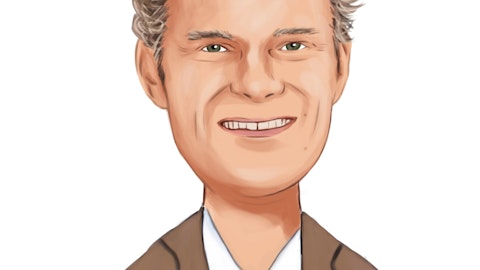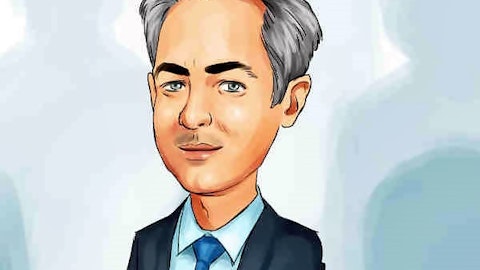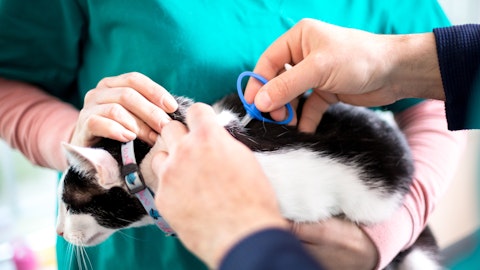Wetteny Joseph : Sure. I will. Look, you’re right, Erin. In terms of — as we said, when you look at ABS at peak, once they ramp up, they will be additive and accretive to our gross margins. We believe they’re also accretive to our contribution margin, even when there are what I’ll say is subscale in terms of getting towards their peak. So as we launch into the U.S., which is a large market, obviously, as you said, we’ll see a little bit of a headwind from a gross margin perspective. But given many of the investments that we need to drive this field force, et cetera, already in the books, if you will. There will be some incremental A&P and DTC. And once we have the right level of penetration of the product in clinics, but that’s still going to leave room for contribution margin lift in the product.
So that will be, I would say, a factor from a gross margin standpoint. But we’ll give more precision in terms of guidance for ’24 at the next call. But as you can read from us and what we’re saying today, we’re very excited about ’24. We’re optimistic on ’24, given the levers I just described. So in line with what we said at Investor Day, we expect to grow in the mid- to high single digits. I think you’ll continue to see us look for margin expansion given the mix up in companion animal versus large [indiscernible], but I won’t give you any more and more specific than that.
Operator: Thank you. We’ll take our next question from Nathan Rich with Goldman Sachs.
Nathan Rich : Great. Thank you, so much the question. I wanted to stick with Librela. And Kristin, specifically ask about how vets are diagnosing OA pain and starting dogs on therapy? You obviously talked about the large number of pets that could benefit from this, but relatively few dogs on treatment. I guess, anything you can share in terms of diagnosis rates for practices that were in the early experience program and where those diagnoses are coming from? Are these dogs currently on a pain product and maybe switching to Librela or these new dogs being diagnosed? Anything there would be great. And then a quick follow-up on the international performance of Librela. It looks like it was roughly flat sequentially on a constant currency basis. Any learnings on seasonality or anything like that on the international side, now that that’s been on the market for a little bit?
Kristin Peck: Sure. A few things I’d say there. Unlike cat pain, which we can certainly talk about if someone has a question on it. Dog OA pain and osteoarthritis has been diagnosed quite well by that. This is not hard to diagnose dogs, unlike cats, do not hide it. You can sense they’re less active. They limp. They don’t want to go upstairs. It is not hard to diagnose. And a lot of these dogs are already being treated. They’re being treated with our product, Rimadyl and other OA products. There’s diets for this is not a space where there’s not a developed market, a developed protocol for diagnosis. That is not the case in cats, where we do have to really develop protocols for diagnosis. What we saw initially is the first dogs they put on are the most symptomatic dogs, where they know that like they really are really struggling.
I think if you look at what we’ve seen in international is as vets get more comfortable with it, they then start providing it for dogs earlier in the OA pain, which actually is even better. They have greater quality of life over time. So our experience of diagnosis is really coming out of international, which is normally initially the dogs they first put it on are the one suffering the most where their pet owners are begging for it. And then over time, you move into earlier stages of OA. But again, this is not one that is hard to diagnose for vets. They have protocols to do that today. So we’re not really as concerned here in the diagnosis part. I think what we really need to do and we see growth in ’24 and beyond in ’25 and ’26 is having that really provide a product like Librela to dog earlier in their disease, which I think will be a good growth driver.
And in international, that is definitely not the case. We’re seeing phenomenal growth right now. It is definitely not flat. But Wetteny, do you want to get into some of the specifics of the international growth situation there?
Wetteny Joseph : Yes, absolutely. Look, if you look at Librela, we delivered $53 million in revenues in Q3. That’s a 65% growth operationally. Now if you look at the preexisting markets, they were up about 33%. So that’s an incremental $10 million or $11 million in the quarter year-on-year growth in the pre-existing markets. And then new markets that have been launched this year is about $10 million that includes a little bit from the U.S. from the early experience program. So year-on-year growth and then sequentially, I think was your question, and we’re still up a few million sequentially. Just keep in mind, Q3 last year, as we said, we have a bit of a tougher comp for Q3, because that’s when we released sort of the allocations that we’re on and the supply constraints. So that is factoring a little bit, but we still had 33% in the in the EU sort of locations in markets where we had previously launched. So that’s still a very robust growth despite the comp.
Operator: Thank you. We’ll take our next question from David Westenberg with Piper Sandler. Please go ahead
David Westenberg: Hi. Thank you for taking the question. Just on 2024 on derm, do you expect the competitive launch outside of the one we already know from Elanco. How comfortable do you feel about your decision to price Apoquel Chewables at parity with your existing products? And are there any analogs for chewables as a competitive differentiator in front of a competitive launch? And just as a quick follow-up on the R&D. It did step down a little bit, and I think you’re guiding for it down. Is there anything are we reading in it too much to say maybe there’s not a new product — a significant new product in 2024, 2025 and maybe reading into that too much.
Kristin Peck : Sure. As we look for competition in dermatology to your question, we are expecting competition in the second half of next year. Our knowledge is that really there’s only one that we’re aware of at this point that we’re expecting in 2024. We obviously don’t know when in the second half that it would be coming. But we’re well positioned for competition. As we’ve been preparing for competition for a while. We both have Cytopoint, we have monopole antibodies. We’ve got Apoquel. We’ve got Chew. We’ve got a pipeline behind that of continued life cycle innovations with longer-duration monoclonal antibodies, other species. So dermatology is a critical portfolio for us. We’re continuing to grow. We did 14% in the quarter.
So we’re going to invest heavily behind this to make sure that we can continue to grow both our portfolio and the market overall. And if you look at chewable pricing, our strategy was let’s move everybody to a product that’s even easier that their dog like even more that they see as a treat, before you have competition, which we’re expecting to be in a film coated tablet, similar to the original Apoquel. So we do see this as a really strong defense strategy for us. We’ve been seeing great as you look at the growth in international in the quarter. It was led by the conversion to Apoquel Chewable. And in the U.S., a lot of the growth in derm for us was also led by retail, which has done really, really well. To your point on R&D, I’ll let Wetteny take it, but there’s absolutely nothing going on there in the sense of any weakness in our portfolio.
But Wetteny, do you want to talk about sort of what drove some of that?
Wetteny Joseph : Yes, absolutely. Look, as Kristin just said, we remain on target with our regulatory milestones with respect to R&D spend was up about 13% year-over-year on the quarter. So clearly, well above our revenue growth rate. So what you’re seeing in terms of our overall expectations for the year versus where we’re landing is just a matter of timing on the span of gross projects, but nothing significant or notable there. Again, we continue to drive innovation, both across new innovation as well as life cycle innovation across our portfolio, and we’re very excited about the progress we’re making in R&D.





